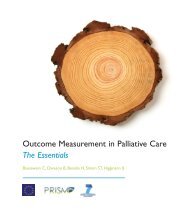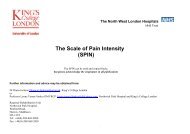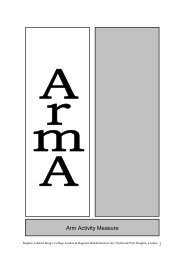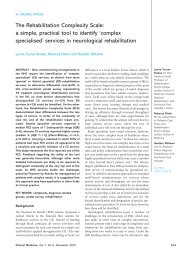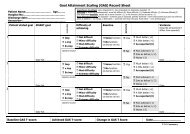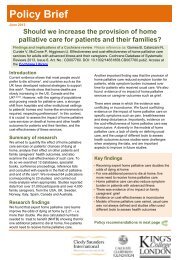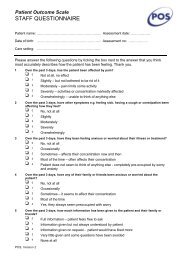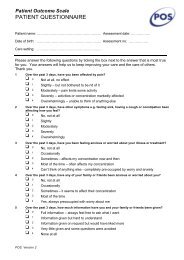Clinical Rehabilitation - King's College London
Clinical Rehabilitation - King's College London
Clinical Rehabilitation - King's College London
Create successful ePaper yourself
Turn your PDF publications into a flip-book with our unique Google optimized e-Paper software.
Development of Northwick Park Therapy Dependency Assessment 925<br />
unit were compared with the results of activity<br />
analysis for the same period (four consecutive<br />
working weeks between 21 November 2005 and<br />
16 December 2005). All 24 therapists (20.3<br />
whole-time equivalents) working on the unit at<br />
the time participated. Disciplines included physiotherapy,<br />
occupational therapy, speech and language<br />
therapy, dietetics, psychology and social<br />
work. The patient cohort consisted of 8 women<br />
and 9 men: mean age 45.5 years (SD 17.1). All<br />
had complex neurological disabilities arising<br />
from acquired brain injury (8 strokes, 5 traumatic),<br />
spinal cord injury (n ¼ 2) or Guillain-<br />
Barre´ syndrome (n ¼ 2).<br />
Data collection<br />
Data were collected in the course of routine clinical<br />
practice. Patients on the unit are normally<br />
divided into two teams (‘Red’ and Blue’) and the<br />
weekly ward round alternates between the teams,<br />
so that each patient is reviewed fortnightly.<br />
Inevitably there were admissions and discharges<br />
during the four-week study period, so that 12<br />
patients were rated on two occasions and 5 were<br />
rated only once, giving a total of 29 parallel sets of<br />
ratings of NPTDA scores with activity analysis for<br />
the corresponding period.<br />
NPTDA scores were applied during the weekly<br />
ward round, by the treating team. They were rated<br />
retrospectively for each patient to reflect a week’s<br />
therapy intervention, based on the average of the<br />
previous two weeks, thus allowing for weekto-week<br />
fluctuations. Scoring took 5–10 minutes<br />
per patient, and this time reduced as therapists<br />
became familiar with the tool.<br />
NPTDA algorithm to calculate estimated therapy<br />
hours: In order to calculate ‘estimated therapy<br />
hours/week’ from the NPTDA scores, we applied<br />
a test algorithm. Within the NPTDA manual, each<br />
item scoring level carries an approximate range of<br />
hours per week (see Appendix 1b). Our first ‘test<br />
algorithm’ simply applied the mid-point time value<br />
for each range (e.g. for a time range 3–4 hours,<br />
value 3.5; range 1–2 hours, value 1.5, etc.). Only<br />
direct interventions could be compared, as the<br />
NPTDA did not record hours for indirect interventions<br />
at this point in its development.<br />
Activity analysis: Over the same four-week<br />
period, each therapist systematically recorded all<br />
activity at half-hourly intervals throughout their<br />
working week. Activity was coded by each therapist<br />
onto a pre-piloted daily timesheet. Activity<br />
codes (full list available from the authors on<br />
request) were divided into patient-related and<br />
non-patient-related activity. Patient-related activity<br />
codes were designed to reflect the NPTDA item<br />
headings. Patient identity codes were used to<br />
assign activities to each individual patient. For<br />
simplicity and practical utility in the context of a<br />
busy service, where more than one therapeutic<br />
activity was undertaken within one 30-minute session,<br />
therapists recorded only the principal activity.<br />
Completed timesheets were handed at the end<br />
of each day and retained by the independent investigator,<br />
so that NPTDA estimations at the subsequent<br />
ward round were conducted independently<br />
of the activity analysis. Out of over 420 timesheets<br />
due for the four-week period, only two were<br />
missing.<br />
Data were collated for each patient under each<br />
item heading in the NPTDA, to build up a series<br />
of individual patient records of therapy intervention<br />
received over the two-week period. The times<br />
were then halved to derive the average hours per<br />
week. As well as recording the ‘actual hours’ per<br />
item for each patient, we also mapped these by<br />
reverse transcription to derive NPTDA scores<br />
from the activity analysis (‘activity analysisderived<br />
NPTDA’ scores), using the time range<br />
stated for each scoring level (see Appendix 1b)<br />
which, as noted above, varies somewhat for the<br />
different items.<br />
Data analysis<br />
Data were collated in specifically developed<br />
software written in Microsoft Excel, and transferred<br />
to SPSS version 11.5 or STATA version 8<br />
for statistical handling.<br />
The association between ordinal NPTDA<br />
scores and actual hours of therapy intervention<br />
(derived from activity analysis) was examined<br />
using Spearman rank correlations.<br />
To evaluate the algorithm for converting raw<br />
NPTDA scores to therapy hours, the median





